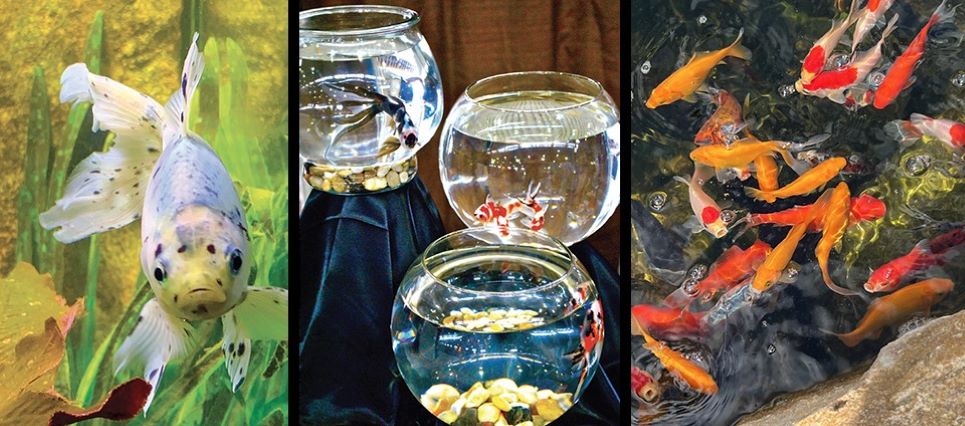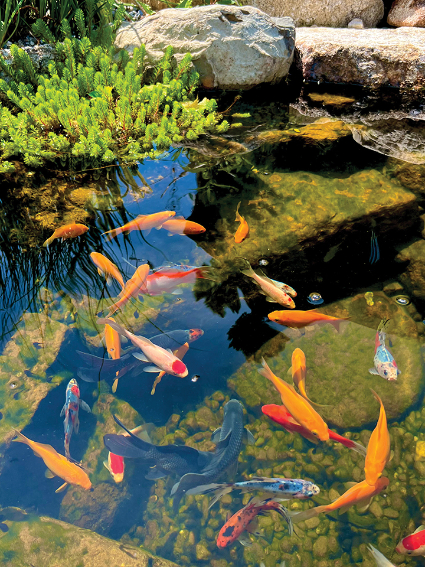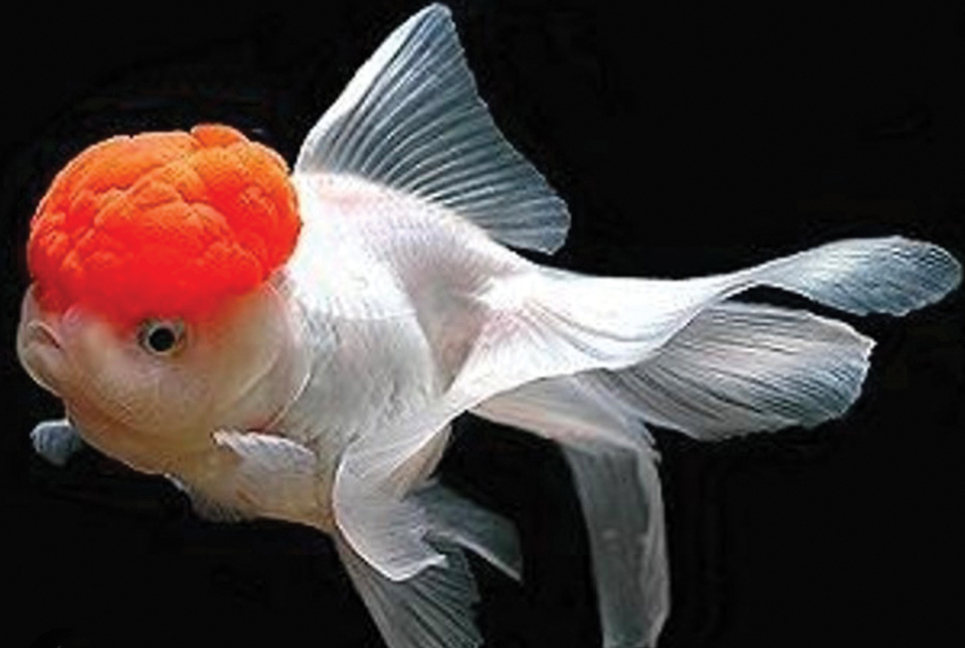
Koi are awesome, right? But how about them goldfish?
It is interesting to see how the once mighty goldfish, or Carassius auratus, has transitioned into a much-overlooked secondary fish-keeping choice for pond owners. After sharing such a long and, at times, esteemed history with human cultures, the goldfish has been relinquished to the sidelines. Koi fish are the new starting line up these days.
Perhaps after so much time together, the goldfish has become blasé to us pond keepers. We’ve become somewhat indifferent to the incredible beauty and fascinating behavior goldfish exhibit. Could the same thing happen to koi when the next pretty fish comes around?
Goldfish Are a Household Name

There is good reason that goldfish are still at least on the playing field of the modern pond keepers. The goldfish is an icon around the world and probably the most recognizable domestic fish species. By the time they are three years old, many children know the image and concept of a goldfish.
Take a look around you. There is goldfish imagery everywhere. Koi still take a backseat to goldfish in today’s modern culture at large. Koi are still relatively exotic and fairly unknown to the world outside of pond keeping. Within the hobby, koi are the new darlings of the pond-keeping scene, but goldfish are ingrained into our multicultural psyche.
This shouldn’t be a surprise. Goldfish have been with us for thousands of years, while koi fish came on the scene a couple of hundred years ago. The farming and cultivation of carp, the base stock of today’s goldfish, extends far back into ancient times. Early crucian carp served as a food source and were also employed as ancient pest control, improving water quality and traded as a commodity. These stock fish were typically gray or olive-colored with occasional color “defects” ranging into red, yellow and orange. Over time, “defective” colored fish were removed from being a food source and cultivated because of their color and beauty.
Some of the first accounts of goldfish breeding appear in China as early as 260 A.D. By this time in history, the human-goldfish connection was very well established. The hobby of keeping the now domesticated goldfish was in practice. Since that time, various cultures and countries have added their breeding preferences into the mix. Japan played a big role in the development of some goldfish types, and many other countries, especially in Europe, practiced selective breeding. These days, Thailand and the Philippines are producing interesting goldfish varieties.
In the almost two millennia that have elapsed, Carassius auratus, with its origins from East Asia, is still with us — still in our homes, our garden ponds, our classrooms, our waiting rooms and lobbies, our fairs and celebrations and our frat parties… (wait, scratch that).
Learn More About Carassius Auratus
The common goldfish, with its stout yet slender-bodied appearance, is not a delicate fish at all. It easily will grow into the range of 12 to 14 inches. Goldfish have very large eyes, very good vision and excellent hearing. Goldfish even have communication by way of grunts, whines and other sounds. Their medium-length fins are paired pelvic fins and pectoral fins, but they have single caudal, anal and dorsal fins. There are no scales on the head of common goldfish, but the body is fully scaled. The age of a goldfish can be told by careful examination of the quantity of rings of its scales.
Goldfish love to explore, grub and forage in their environment using their forward-facing mouth as the main tool of exploration. Like koi fish, they have pharyngeal teeth in the back of their throat to help crush foods. Goldfish will accept a wide range of prepared foods but will do best with a healthy pellet food in captivity. They will eagerly accept foods such as krill, bloodworm, earthworm, shelled peas, zucchini and other treats. They will also graze on algae from rocks within their pond and take down any small insects that happen to land in a goldfish pond. Mosquitoes don’t stand a chance!
Goldfish are non-predatory, non-territorial, peaceful, schooling fish. They are curious and social fish, very active in the pond and don’t hesitate to interact with humans, dogs, cats and even herons. The buoyant, cheerful, eager disposition of goldfish is a big part of what endears them so much to humans. Of course, the bright colors of the goldfish complement their merry personalities.
The goldfish is quite forgiving when it comes to water quality, handling a broad range of water parameters. They are cold-water fish and handle the harsh winters of the northern climates without issue. Goldfish seem to do just fine in everything from a kid’s backyard bucket to a professionally installed pond or state-of-the-art aquarium facility. Of course, the classic goldfish bowl is a testament to how easily kept these fish are — the species is included among a small group of fish that can take oxygen directly from the atmosphere by “gulping” air from the surface of the pond or enclosure they are in, which is why they can stay in unequipped goldfish bowls. Goldfish can also tolerate a wide range of environmental conditions, thriving in most climates around the world.

Raising Goldfish
Goldfish typically spawn during late spring to early summer. The summer solstice is a good time of year to use as a marker for high levels of spawning activity. However; goldfish that are well conditioned have the ability to spawn several times throughout the season. Goldfish are broadcast egg layers, meaning they spray their eggs across a broad area. Many fish will choose a particular rock or leaves to lay and protect their eggs on, but the goldfish is not one of these fish. The female will typically spray her eggs into a planted area or along the edges of a pond. The males will follow up by fertilizing the eggs with their milt.

The spawning behavior of goldfish is usually quite raucous, with lots of frenzied activity within the pond. Chasing, nipping and even breaching the water are very typical spawning behaviors, which may appear to be fighting or aggression to the untrained eye. At times, the courtship can seem brutal, and the female goldfish can indeed become injured. Once the courtship is complete and eggs have been expressed, the water conditions within the pond will often become very murky. Even a foamy surface condition can occur, and a fishy smell may linger for a short time. Goldfish are notorious for eating their own eggs, sometimes to the point of not leaving any eggs to grow out a new generation of goldfish.
Of course, one could remove eggs from the pond should they want to raise the fry, which is easier than it may seem and a rewarding experience. There has been great patience and discipline over the centuries by those who do practice the rearing of goldfish. Through selective breeding, the types and varieties of goldfish available are plentiful. Varieties such as red comets, shubunkin, sarasa comet, apricot comet, yellow comet, bronze comet and other varieties will have the classic Carassius auratus body shape.
Goldfish enthusiasts will also find dozens of varieties of ornamental goldfish these days. The ornamental varieties come in varying body shapes, varying scalation, varying fin arrangements and lengths or lack thereof — even ornamental head growth in the oranda varieties. The most ornamental types of goldfish, such as bubble eye, celestial eye and pom pom varieties, are not the best candidates for outdoor pond keeping. The ornamental varieties are best kept in very controlled conditions or aquarium-type environments. Also beware of mixing the very ornamental goldfish with koi fish and other pond fish due to the ornamentals’ more delicate disposition. Goldfish varieties with the classic body shape generally do very well mixed among koi fish.
Go For the Gold
If one should get involved in the breeding of goldfish, a trip to a goldfish show might be in their future. Like koi, and often along with koi, fish keepers can find goldfish shows all over the world. These events are great fun and provide attendees with access to the goldfish world that won’t be found in a retail environment. Award-winning goldfish and new varieties will be found at these shows, with opportunities to meet the breeders, professionals and other enthusiasts. Goldfish shows have been popular since the 1800s and treat the visitors to a dizzying and colorful array of goldfish. During the Victorian era, when goldfish were en vogue, the goldfish shows were very popular and well attended high-society events.

Throughout its history, the goldfish has gone from a food source to being revered by royalty and even protected by law and decree. At one time, ownership of the yellow goldfish was punishable since that particular color was reserved for the emperor. Goldfish have been the center of cultural trends, even given as a traditional wedding gift, and spawning various goldfish societies such as the British Goldfish Society. In the mid-1800s, having a goldfish bowl in the home parlor was considered very chic and elegant. Keeping goldfish was considered healthy and good for the minds of children.
Door-to-door goldfish vendors and street hawkers were not uncommon during those times. In early America, goldfish farms were among the earliest aquaculture industries that sprung up. There were even government programs that provided goldfish to the citizens and encouraged the building of ponds. However, the ponds were more utilitarian and not for the enjoyment like we experience today.
Even though the glory days of the goldfish are likely not returning any time soon, pond professionals can educate and encourage new pond owners on the keeping of these incredible historically valuable fish. There is no doubt they will fall in love with their goldfish. They have earned the moniker of water puppies for a reason. Maybe with some fresh interest in the keeping of goldfish, the longtime relationship with humans will continue for another 1,000 years. Perhaps someday we will see goldfish in outer space — I’d put money on it!
Today’s modern pond professionals are in just the right position to keep this age-old tradition alive well into the future. Goldfish have been allegiant to us for a very long time, so let’s return the loyalty.
About the Author
Mike Gannon is the owner of Full Service Aquatics, located in Summit, New Jersey. Mike has been a lifelong pond enthusiast and fishkeeper.


Thanks for all the info. I have a 1/2 acre pond behind my house It’s named the turtle pond, because of its Red eared Sliders. From 2 inch babys to 16 inch Mothers. They are neighbors, not pets. In their pond I put 100 feeder 3 inch goldfish from Pet Smart. Sixteen months later about 30 survived, and are 12 to 16 inches now approx 2 lbs. I feed them
everyday. It’s like a large aquarium.
Again thanks….